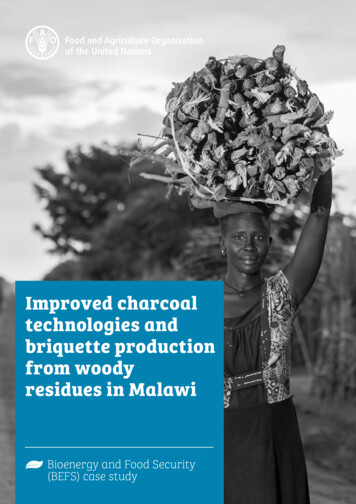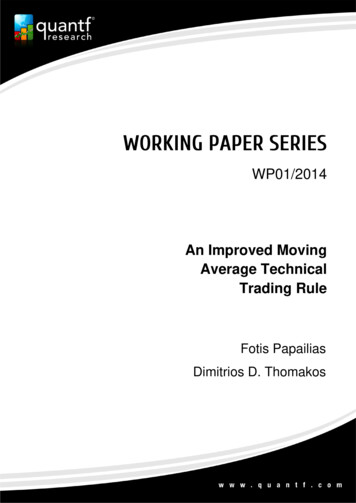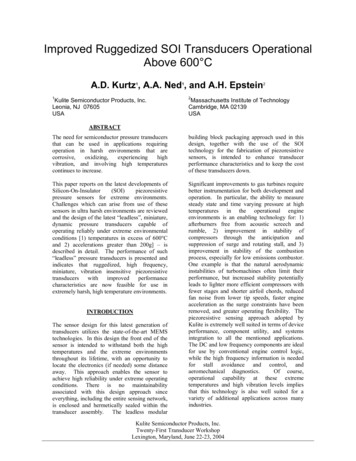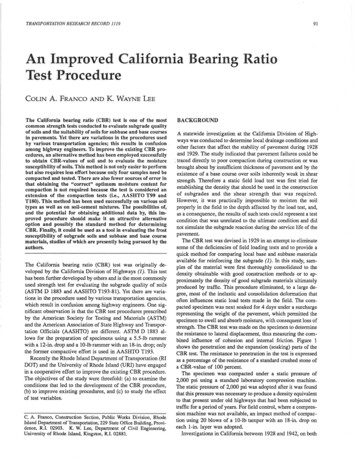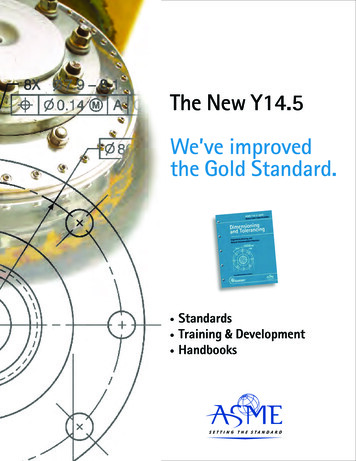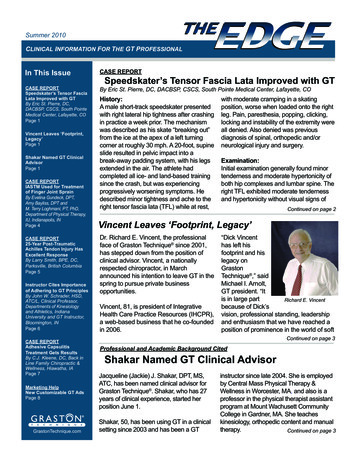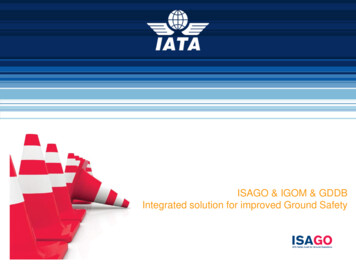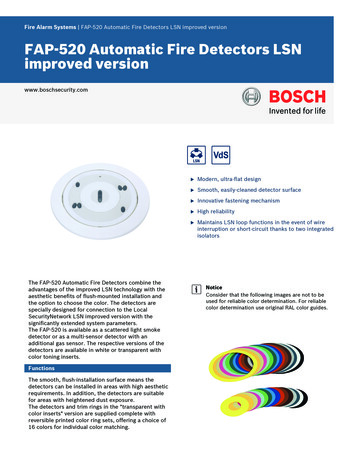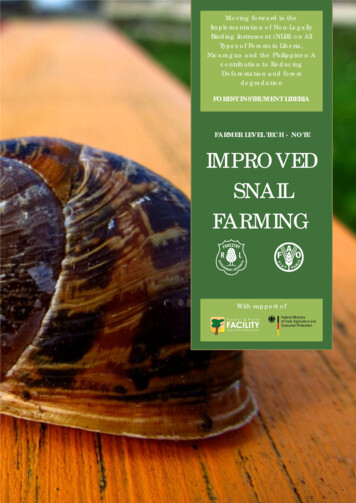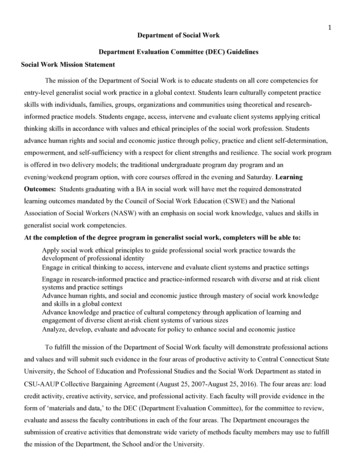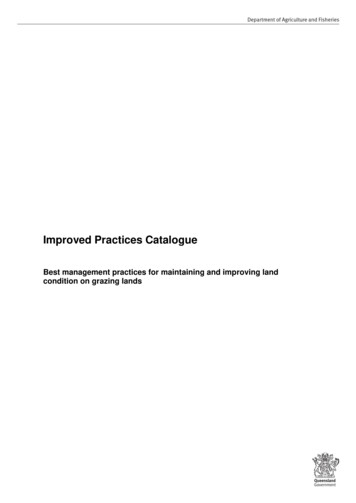
Transcription
Improved Practices CatalogueBest management practices for maintaining and improving landcondition on grazing lands
2This publication has been compiled by Timothy Moravek, Kate Brown and Holly Reid of the Department of Agriculture andFisheries.The authors would like to thank Mick Sullivan, Isabel Bryce, Leigh Smith and others from the Department of Environment andHeritage Protection for their valuable input. State of Queensland, 2017The Queensland Government supports and encourages the dissemination and exchange of its information. The copyright inthis publication is licensed under a Creative Commons Attribution 4.0 International (CC BY 4.0) licence.Under this licence you are free, without having to seek our permission, to use this publication in accordance with the licenceterms.You must keep intact the copyright notice and attribute the State of Queensland as the source of the publication.Note: Some content in this publication may have different licence terms as indicated.For more information on this licence, visit https://creativecommons.org/licenses/by/4.0/.The information contained herein is subject to change without notice. The Queensland Government shall not be liable fortechnical or other errors or omissions contained herein. The reader/user accepts all risks and responsibility for losses,damages, costs and other consequences resulting directly or indirectly from using this information.
3TABLE OF CONTENTSWhat are improved practices? . 4What can you find in this catalogue? . 4What is land condition and how can you tell if it is degraded? . 4Maintaining land condition. 7Managing land condition with stocking rates and wet season spelling . 7Rehabilitating degraded country . 11Rehabilitation of poor (C-Condition) or very poor (D-Condition) condition country . 12Rehabilitation of gullied areas . 14Decision Support Tools . 18Breedcow and Dynama . 18BRICK . 18FORAGE . 19Grazing BMP . 19Stocktake Plus . 20Veg Machine . 20Table of figuresFigure 1: Land in ‘A’, or good, condition . 5Figure 2: Land in ‘B’, or fair, condition . 5Figure 3: Land in ‘C’, or poor, condition . 5Figure 4: Land in ‘D’, or very poor, condition . 5Figure 5: Results from the Wambiana grazing Trial, Burdekin catchment . 8Figure 6: Results from the Galloway Plains grazing trial, Central Queensland . 9Figure 7: Long Term Carrying Capacity vs Stocking Rate . 10Figure 8: Results from a land rehabilitation trial Spyglass Research Station, Burdekin Catchment . 12Figure 9: Results from a land rehabilitation exercise, Fitzroy Catchment . 13Figure 10: General costing information on gully rehabilitation methods . 14Figure 11: Case study of gully rehabilitation,Burdekin catchment . 15Figure 12: Case study of gully rehabilitation, Fitzroy catchment . 15Best management practices for maintaining and improving land condition on grazing lands, Department of Agricultureand Fisheries, 2017
4What are improved practices?Improved practices are practices that science has verified will improve land condition, environmentaloutcomes, such as water quality, and business profitability and productivity. In many cases, improvedpractices are already being used on extensive grazing properties across Australia. The improvedpractices are recommended to prevent degradation of land condition or, where degradation hasalready occurred, to improve land condition.Simply, the improved practices come under a few major themes:1. Managing land condition with stocking rates and wet season spelling.2. Rehabilitating poor (c-condition) and very poor (d-condition) country.3. Rehabilitation of gullied areasWhat can you find in this catalogue?This catalogue aims to provide graziers with a brief overview of outcomes which may occur onproperty as a result of adopting these improved practices. More importantly, it will provide anextensive set of links to where more comprehensive information can be obtained for those wantingmore detail.For a more complete guide, please refer to Sustainable management of the Burdekin grazing landsavailable at kinGrazing final-04a.pdf andUnderstanding the economics of grazing management practices and systems for improving waterquality run-off from grazing lands in the Burdekin and Fitzroy Catchments available at the QueenslandGovernment Publications Portal or at this link - https://goo.gl/6gcvnCWhat is land condition and how can you tell if it is degraded?Assessing land condition can assist in determining the capacity of grazing land to produce usefulforage. It is a measure of how well the grazing land ecosystem is working and is dependent on anumber of factors including: how well sunlight is being captured and converted into feed how well nutrients are being cycled how well rainfall is being used to grow grass.Land condition is therefore directly related to carrying capacity, livestock production and profitability ofgrazing enterprises. Land condition is a relative measure of the health of grazing lands. It has threecomponents which can be assessed, measured and monitored: soil condition - presence of organic matter, level of erosion and scald features pasture condition- presence and density of 3P (perennial, productive and palatable) grassesand amount of ground cover prevalence of weeds and woodland conditionBest management practices for maintaining and improving land condition on grazing lands, Department of Agricultureand Fisheries, 2017
5Land condition can be classified into four broad categories:A Condition Dominated by 3P grassesLittle bare ground (less than 30%)Good soil condition, no erosionFew weeds and no sign, or only earlysigns of woodland thickeningFigure 1: Land in ‘A’, or good, conditionB Condition Decline of 3P grassesIncreasing bare ground - between30% and 60%Some decline in soil conditionSome signs of past erosionIncreasing weeds and woodlandthickeningFigure 2: Land in ‘B’, or fair, conditionC Condition Significant decline of 3P grassesLarge amounts of bare ground - above60%Current erosion or susceptibility toerosion is highThickening of weeds and woodlandsFigure 3: Land in ‘C’, or poor, conditionD Condition Little to no 3P grassesSevere erosionLittle to no ground coverWeeds and woodland thickets presentFigure 4: Land in ‘D’, or very poor, conditionBest management practices for maintaining and improving land condition on grazing lands, Department of Agricultureand Fisheries, 2017
6Want more information?Since there are likely to be several different land types on a typical grazing property, each with theirown unique characteristics, it is important to understand the characteristics of land condition relevantto your e/land-condition/ - this link will take you to a more in-deptharticle on land e/pasture-photo-standards/ - this link has a pasture photostandards for 39 different land types. Each set of pasture photo standards contain photos of a rangeof dry matter pasture srangelands/ - this link has land condition photo guides (similar to the ones on the previous page),providing a comprehensive guide on various pasture communities, soil condition and ground coverthresholds, typical tree varieties and potential yields for 14 different land types in the BurdekinCatchment for each of A, B, C and D condition land.Best management practices for maintaining and improving land condition on grazing lands, Department of Agricultureand Fisheries, 2017
7Maintaining land conditionCommon sense suggests that it is better for the hip pocket to maintain land in a good condition ratherthan allowing degradation to occur and having to rehabilitate it now, or sometime in the future. Theimproved practices (see “What are improved practices”) can facilitate maintaining good land condition.This section provides a snapshot of the economic and environmental results of studies which haveused these practices to maintain land condition and some key places more information can beobtained. Forage budgeting- use a tool like Stocktake Plus (http://www.stocktakeplus.com.au) tohelp you calculate how long your pasture will last.Stocktake Plus can also be used to estimates your long term carrying capacity (LTCC)based on your land types and closest rainfall station.Knowing about Adult Equivalents (AE’s) helps you determine how much grass yourcattle require. An AE is a 450 kg live weight dry animal that is maintaining weight.Pregnancy testing will assist you to know how many new calves will be coming duringthe calving season and how many lactating breeders the pasture will be carrying.Lactating breeder require up to 35% more pasture than dry stock of equivalent weight.Photo monitoring sites are useful for tracking land condition over time. Stocktake Plusalso has functions to assist with this.Managing land condition with stocking rates and wet season spellingThe key practices for managing land condition and ground cover through stocking rate and spellingmanagement include:1) Monitor land condition and recognise signs of decline2) Match stock numbers to forage available3) Manage for the desirable pasture species4) Plan a stocking / grazing strategy that includes regular spellingBy following these basic principles, land condition can be sustainably maintained. Long termresearch has been conducted to investigate the effect of stocking rates and spelling regimes on landcondition. Results from the Wambiana grazing trial in the Burdekin Catchment and the GallowayPlains grazing trial in Central Queensland can be seen in Figure 5 andFigure 6.Best management practices for maintaining and improving land condition on grazing lands, Department of Agricultureand Fisheries, 2017
8Figure 5: Results from the Wambiana grazing Trial – a long term stocking rate trial in the Burdekin CatchmentWhat stocking rates were researched?Did it work (i.e. maintain land condition,minimise sediment run-off? Heavy stocking (2x LTCC) Moderate stocking (at LTCC) Variable stocking (based onavailable forage)Variable stocking (based on SOI)Rotational wet season spelling (1.5xLTCC) How much money did it make? 8,000/100ha 24,000/100ha Pasture condition and cover hasdeclined dramaticallyPasture condition was maintained,minimised run-offPasture condition declined 23,000/100ha Pasture condition declinedPasture condition improved 24,000/100ha 23,000/100ha. Note: This is accumulated Gross Margins over 19years of the trialLong Term Carrying Capacity vs Stocking RateResearchers notedrecovery ofLong term carrying capacity (LTCC) is the average number of cattle a property, or paddock, cansustainably carry over a planning horizon (10 years plus). Consequently, it is a criticalconsideration for business planning, property purchase and development.heavily stocked paddocksStocking rate is the number of animals carried at a point in time. It may be above or below theLTCC of the paddock or property. It will vary from LTCC due to variation in rainfall received andthe response of the pasture.during better years was“visually impressive”but“largely cosmetic”, andhad no recovery of 3P grassesBest management practices for maintaining and improving land condition on grazing lands, Department of Agriculture and Fisheries, 2017
9Figure 6: Results from the Galloway Plains grazing trial – a 13 year stocking rate trial in Central QueenslandWhat stocking rates were researched?Did it work (i.e. maintain land condition,minimise sediment run-off?How much money did it make? The trial demonstrated that there was asignifican
5 . Best management practices for maintaining and improving land condition on grazing lands, Department of Agriculture and Fisheries, 2017 . Land condition can be
